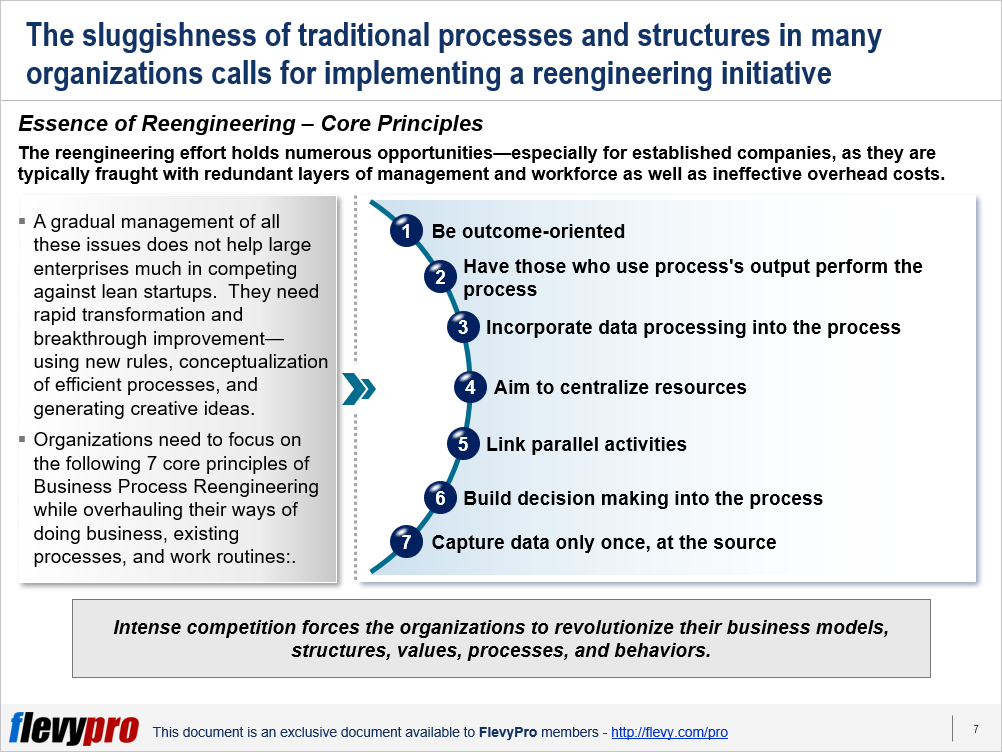With the advancement in technology, the usual emphasis on cost, growth, and control has been replaced by a laser focus on innovation, customer service, quality, and employee empowerment. Obsolete business processes, disjointed organizations, fragmented work routines, and complex performance management mechanisms in traditional firms have not been able to cope with the revolutionary business models and practices that startups are employing to disrupt established players.
Automation of existing processes alone to achieve productivity gains does not benefit the organizations much. In fact, this is one of the chief reasons for sub-standard performance. With time, these work routines become deep rooted and hard to challenge despite their significant flaws. Fragmented conventional processes and disjointed structures are the main cause of bureaucratic red tapes, slipups, cost inefficiencies, and unclear roles and responsibilities.
All these problems and inefficiencies document the need for Business Process Reengineering (BPR). BPR helps the organizations get rid of outmoded business processes, fundamental beliefs and values, and replace them altogether. Competing against lean startups necessitates examining the businesses processes from a holistic and cross-departmental perspective, and dissecting every step of the existing processes in terms of the value they add. A BRP initiative requires deploying a cross-functional team to develop innovative ideas, conceptualize efficient processes, and lay out new systems and policies to trigger breakthrough product and process improvements.
In essence, organizations need to focus on the following 7 core principles of Business Process Reengineering while overhauling their ways of doing business, existing processes, and work routines:
- Be outcome-oriented
- Have those who use process’s output perform the process
- Incorporate data processing into the process
- Aim to centralize resources
- Link parallel activities
- Build decision making into the process
- Capture data only once, at the source
Now, let’s discuss the first 3 principles of BPR in detail.
Be Outcome-oriented
The centuries-old philosophy of specialized departments dedicated to deal with a certain type of work sequentially—having teams possessing a specific skill-set—has become obsolete. This way of doing business experiences various issues—numerous handoffs, delays, lack of proper communication, misinterpretation of information, and rework.
BPR calls for elimination of multiple handoffs, elimination of redundancies, and allocation of responsibilities judiciously to the right persons, who supervise the entire process—for instance, from order entry, to product delivery, through to installation. Reengineering begins by redesigning all jobs with a focus on outcomes rather than tasks. The initiative expedites organizational processes and offers the customer a single point of contact.
Have Those Who Use Process’s Output Perform the Process
Specialized departments handling specialized processes are slow to react and are quite bureaucratic. With this type of structure, even to get new paper clips, a department formally requests the procurement department, which contacts the vendors, places orders, makes payment, eventually gets the paper clips, and delivers to the department that requested the item.
It is important that the people that own a process perform it. This aids in getting rid of a number of liaisons and planning capacity for the process performers appropriately. Through automation and process reengineering individual units can avoid too many handoffs and uncalled for delays thereby saving precious time and expenditure. For instance, to procure something, specific units can place their order themselves and purchase what they need from pre-approved vendors through credit cards.
Incorporate Data Processing into the Process
Traditionally, most leaders believed that workforce at the lower organizational tiers is incapable of taking any action on the information they produce. Many organizations, even today, create specialized teams and units to do that, as the people who produce the information often do not have the time and capabilities to process that.
Leadership needs to believe in, coach, and encourage their people in the lower ranks—who produce the information—to acquire the capabilities required to process data and make sound decisions. Utilizing technology, organizations now can develop and deploy systems to help their people compare and process data received from different units and initiate appropriate action.
Interested in learning more about the other principles of BPR? You can download an editable PowerPoint on 7 Principles of Business Process Reengineering here on the Flevy documents marketplace.
Are you a Management Consultant?
You can download this and hundreds of other consulting frameworks and consulting training guides from the FlevyPro library.
Want to Achieve Excellence in Process Improvement?
Gain the knowledge and develop the expertise to become an expert in Process Improvement. Our frameworks are based on the thought leadership of leading consulting firms, academics, and recognized subject matter experts. Click here for full details.
Process Improvement involves analyzing and improving existing business processes in the pursuit of optimized performance. The goals are typically to continuously reduce costs, minimize errors, eliminate waste, improve productivity, and streamline activities.
As we continue to deal with COVID-19 and its economic aftermath, most organizations will prioritize Business Process Improvement initiatives. This is true for a few reasons. First, Process Improvement is one of the most common and effective ways of reducing costs. As the global economy slows down, Cost Management will jump to the forefront of most corporate agendas.
Secondly, a downturn typically unveils ineffective and broken business processes. Organizations that once seemed agile and focused during periods of growth may become sluggish and inefficient when demand drops off.
Lastly, COVID-19 has expedited Digital Transformation for most organizations. One of the quickest and most impactful forms of Digital Transformation is Robotic Process Automation (RPA). Thus, we have included numerous RPA frameworks within this Stream.
Learn about our Process Improvement Best Practice Frameworks here.
https://flevy.com/blog/7-principles-of-business-process-reengineering-bpr/

Posting Komentar
Posting Komentar